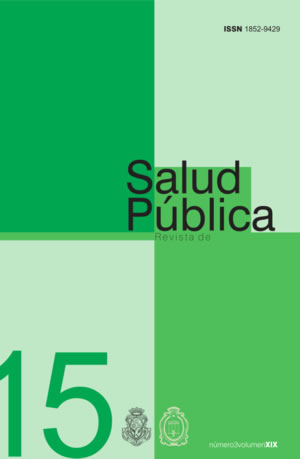A LOOK AT PSYCHOMOTRICITY CARE IN PUBLIC HEALTH SERVICES
DOI:
https://doi.org/10.31052/1853.1180.v19.n3.13070Keywords:
psychomotricity care, health-illness process, health organization, body and biopoliticsAbstract
At public health institutions in the province of Cordoba, we can observe an asymmetric participation between medical professions and other professions such as psychomotricity. This reality is observed in public health care centers in the city of Rio Cuarto. We critically think about the definition of the health-illness processes, comparing the current paradigms and Psychmotricity theory and asking about the ways in which the inclusion of this discipline is understood in the provincial public policies and in the legislation in force. The research was carried out through field work to get to know the opinion and assessment regarding health care and psychomotricity care and its legal framework by means of surveys and interviews to health social actors: doctors and local civil servants, among others. It is observed that the constitution of the health teams is incomplete; there exists professional bias which is still priorly constituted by the medical sciences. The intention of our analysis is to contrast medical knowledge and psychomotricity knowledge to set up reflection spaces which will allow the necessary transformations to take care of health recovery, prevention and promotion.
Downloads
References
.1. Ballarino, M; Domijan Deymié, A; Gabbi, J; Gelmetti, M; Rova, V; Sarnago, M. (2004) Hacia una conceptualización de salud Psicomotríz en saberes y haceres: un camino recorrido entre todos. Córdoba, Argentina: Ediciones del boulevard. S.R.L.
2. Barroso, A; Parrone, M. (2004). La Psicomotricidad en el ámbito de la salud pública en saberes y haceres: un camino recorrido entre todos. Córdoba, Argentina: Edicio-nes del boulevard. S.R.L.
3. Bowlby, J. (1989). Una base segura. Aplicaciones clínicas de una teoría del apego. Buenos Aires, Argentina: Editorial Paidos.
4. De Ajuriaguerra, J; Angelergues, R. (1962). De la psicomotricidad al cuerpo en la relación con el otro. A propósito de la obra de Henri Wallon en Revista La Hamaca. Cuerpo- Espacio- Identidad, N° 10. Buenos Aires, Argentina: Fundari-Cidse.
5. De Ajuruaguerra, J. (1973). Manual de psiquiatría infantil. Barcelona, España: Edi-torial Masson. S.A.
6. Foucault, M. (2012). Nacimiento de la biopolítica. Buenos Aires, Argentina: Fondo de cultura económica.
7. __ (2008). El nacimiento de la clínica. Buenos Aires, Argentina: Siglo XXI Editores Argentina.
8. Ministerio de Salud y Ambiente de la Nación. (2006). Salud y Sociedad en Posgra-
58Revista de Salud Pública, (XIX) 3:45-58 Diciembre 2015 Una mirada sobre la atención psicomotríz en los servicios de salud pública / Susana Chiodi, Marcela A. Tobares, Cecilia Harriaguedo en Salud Social y Comunitaria. Módulo I. Buenos Aires, Argentina: Responsable Editorial Mariela Rossen. 1° ed. Mi-nisterio de Salud.
9. Samaja, J. (2007). Epistemología de la Salud. Reproducción social, subjetividad y transdiciplina. Buenos Aires, Argentina: Lugar Editorial S.A.
10. Silva Paim, J. (2011). Desafíos para la salud colectiva en el siglo XXI. Buenos Aires, Argentina: Lugar Editorial.
11. Testa, M. (2007). Decidir en Salud: ¿Quién? ¿Cómo? Y ¿Por qué? Salud Colectiva. 2007, 3 (3):247-257.Winnicott, D. (1992). Los procesos de maduración y el ambiente facilitador. Estudios para una teoría del desarrollo emocional. Barcelona, España: Editorial Paidos
Downloads
Published
Issue
Section
License
Copyright (c) 2015 Escuela de Salud Pública y Ambiente. Facultad de Ciencias Médicas. Universidad Nacional de Córdoba

This work is licensed under a Creative Commons Attribution-NonCommercial 4.0 International License.
Authors who publish with this journal agree to the following terms:
- Authors retain copyright and grant the journal right of first publication with the work simultaneously licensed under a Creative Commons Attribution License which allows the work to be copied, distributed, exhibited and interpreted as long as it is not done for commercial purposes.
- Authors are able to enter into separate, additional contractual arrangements for the non-exclusive distribution of the journal's published version of the work (e.g., post it to an institutional repository or publish it in a book), with an acknowledgement of its initial publication in this journal.
- Authors are permitted and encouraged to post their work online (e.g., in institutional repositories or on their website) after the publication process. (See The Effect of Open Access). (See The Effect of Open Access).







